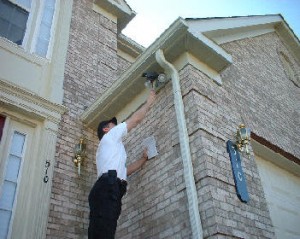 If you are looking for a state-of-the-art security system for your house, try using wireless security cameras for homes. Wireless security cameras for homes come in many different varieties making them incredibly versatile in application, and thanks to modern technology the prices are affordable too.
If you are looking for a state-of-the-art security system for your house, try using wireless security cameras for homes. Wireless security cameras for homes come in many different varieties making them incredibly versatile in application, and thanks to modern technology the prices are affordable too.
Not long ago, security camera systems used Closed Circuit Television cameras that sent an analog video signal to a processor/recorder that made the signal useable for viewing and recorded it on video tape. Tape cartridges were either replaced when they were full or special loop cartridges would repeat recording new video over older footage.
Digital video cameras and other modern technology has drastically changed surveillance cameras and their applications and made it possible to utilize wireless security cameras for homes. Video tape is no longer needed because the newest cameras are digital video cameras. Instead of sending an analog signal, these cameras send digital video signals which can be stored on digital hard drives or Digital Video Recorders (DVR). These cameras have also made it possible to have wireless security cameras for homes.
The major difference between wireless security cameras for homes and cameras that are “wired” is that the wireless camera has its own on-board transmitter and antenna. The wireless camera transmits its digital video signal via the antenna to a receiver, which is normally located near the monitor and/or DVR. Not only has using digital video made this possible but the advanced technology behind the 2.4 and 5.8 GHz radio band has permitted ranges for these cameras up to two miles.
Most wireless security cameras for homes are not entirely without wires. Although they transmit their video signal via radio waves, they still must receive some sort of electrical power supply. Generally this power supply is in the form of a thin wire that carries low voltage DC current from an AC power adaptor that is plugged in nearby or from a power distribution box that performs the same function for many cameras. However, eliminating the coaxial transmission wire means that it is not necessary to cable each camera to the processor/DVR unit. Basically, installing a wireless camera is as easy as mounting the camera and plugging it into the power source.
Wireless security cameras for home can be indoor or outdoor types. Outdoor models are much like indoor models except they are enclosed in a protective cover or case. Outdoor cameras are usually rated using an International Electrical code standard. The rating, called an Ingress Protection or IP code, helps to define how much protection the case provides. Generally, most outdoor cameras are rated IP66 or IP67. Both ratings indicate the camera is dust tight; IP66 means it can withstand powerful jets of water and IP67 means it can be submerged in up to one meter of water without damaging the camera.
Wireless security cameras for home produce high quality color digital video. These cameras contain a sensor chip that transfers the light image focused on it from the lens into an electrical signal. One of two sensors is used; either a Charged Coupled Device or CCD or a Complimentary Metal Oxide Semiconductor or CMOS.
These sensor chips can be so sensitive that they can produce high quality color video images in very low visible light conditions. Cameras that have these special sensitive chips are call day/night vision cameras and are often rated as to the degree of light that needs to be present to produce an image. The rating used is “lux” and cameras can be as sensitive as .002 lux; this light intensity rating is equivalent to the amount of visible light seen in a moonless clear night sky.
Other wireless security cameras for home may be night vision infrared cameras. These cameras can detect infrared (IR) illumination that is invisible to the human eye. The camera normally comes with several IR Light Emitting Diodes or LEDs that provide IR light for the camera. Since the light emitted is in the near infrared spectrum our eyes cannot detect it. These cameras are excellent for use as baby monitors.
Other options available for these cameras include the ability to record audio, Pan-Tilt-Zoom (PTZ), and cameras that use rechargeable batteries instead of a power supply.
Today’s innovative technology has presented us with wireless security cameras for home for just about any purpose or environment. Wireless security cameras for home are as cinch to install and are reasonably priced as well.











